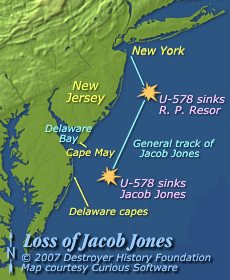

Three-month old Jacob Jones locks through the Panama Canal in 1920. View this and five other images in detail.

Laid down 21 February 1918, launched 20 November and commissioned 20 October 1919, the new ship operated briefly in the Atlantic, then joined the Pacific Fleet in January 1920. Except for a period in reserve between August 1920 and June 1921, she was active along the West Coast until decommissioned and laid up in June 1922.
The “Jakie” recommissioned in May 1930, one of 60 mothballed flush-deckers returned to service in a crash program to replace a like number of ships discovered to be unfit for active duty. Until the spring of 1933, she operated in the eastern Pacific with one tour in the Caribbean; then moved permanently to the Atlantic.
Jacob Jones crossed the Atlantic in late 1938 to join Lisbon-based Squadron 40-T with four-stack cruiser Trenton and destroyer Badger. They operated “in the western Mediterranean for the purpose of cultivating friendly relations and protecting American interests,” but returned to the United States in October 1939 after World War II broke out the previous month.
The outbreak of World War II in Europe in 1939 signaled the beginning of a German submarine onslaught against transatlantic shipping—a strategy first seen during World War I. By January 1942, the allies had adopted a preliminary answer: a convoy system with an acceptable level of protection, made possible by deploying every available escort vessel in this service. That month, transatlantic convoys lost only three merchant ships. Unprotected, however, was merchant shipping along America’s East Coast.

“No more perfect set-up for rapid and ruthless destruction could have been afforded the Nazi sea lords … ‘The massacre enjoyed by U-boats along our Atlantic Coast in 1942 was as much a national disaster as if saboteurs had destroyed half a dozen of our biggest war plants’.”
— Morison
Commanding the Eastern Sea Frontier—a territory from the Canadian border to Jacksonville, Florida and from the coast 200 miles seaward—was VAdm. Adolphus (“Dolly”) Andrews, who commandeered every available cutter, patrol craft, armed trawler, yacht and patrol aircraft. But such resources—on which the convoy system depended—wer e scarce when Germany declared war on the United States on 11 December 1941. The next day, Hitler ordered a blitz against undefended east coast shipping known as Operation Paukenschlag (“Drumbeat”).
Six U-boats arrived off the East Coast in January 1942. There they began sinking merchant ships at the rate of one per day. Through April, as their numbers grew, U-boats sank 82 merchant ships in the Eastern Sea Frontier and 55 more in the Bermuda Area, none of which were in convoy.
Desperate, Admiral Andrews asked for fifteen destroyers and was allotted seven on temporary detail to conduct “roving patrols.” These proved ineffective—Jacob Jones became an immediate casualty and their only sinking was Roper’s destruction of U-85 by gunfire in mid-April.
In May, however, with an adequate number of escorts available at last, the convoy system was adopted from Halifax to Key West and the number of losses dropped to five. As the preponderance of sinkings shifted south to the Gulf of Mexico and Caribbean, June was the last month when more than six merchant ships were lost in the Eastern Sea Frontier.
Attached to Destroyer Squadron (DesRon) 27, Jacob Jones was assigned with DesDiv 54 sisters Roper, Dickerson and Herbert to the Atlantic Coast Sound School on its reorganization at Key West, Florida in December 1940. During the next two years, she also participated in Neutrality Patrols off the East Coast and in the Caribbean area and, with the United States’ entry into World War II in December 1941, commenced escorting convoys from Argentia, Newfoundland.
In February 1942, under the command of LCdr. Hugh D. Black and executive officer LCdr. Thomas W. Marshall, Jr., Jacob Jones became the first destroyer assigned to roving anti-submarine patrols off the East Coast. Even before clearing the New York entrance channel on her first such patrol, she contacted and attacked a U-boat. While an oil slick suggested success, postwar German records did not show any U-boat lost at that time.
Standing out of New York Harbor again on 27 February, the “Jakie” was originally assigned to patrol between New Jersey’s Barnegat Light and Five Fathom Bank off Cape May, then ordered south to the area off Cape May and the Delaware Capes. Enroute she encountered the drifting wreckage of the 7,451-ton tanker R. P. Resor, torpedoed that morning by U- 578. After pausing for two hours to search for survivors, she resumed her patrol to the southwest.
Before dawn the following morning, Jacob Jones herself encountered U-578, but without making contact. Without warning, two torpedoes hit her port side. One detonated her forward magazine, destroying everything and everyone forward of the No. 2 stack. The second hit astern, obliterating everything aft of the point of impact. There may have been a third.
An estimated 30 officers and men abandoned ship. Depth charges exploded as she sank, however, killing many in the water—none of her seven officers and only eleven of her men survived. An army observation plane spotted her rafts and reported their position to Eagle 56 of the inshore patrol, which rescued survivors 4–5 hours later and took them to Cape May.
In 1943, Fletcher-class destroyers Black (DD 666) and Marshall (DD 676) were named for her CO and XO and launched at Federal Shipbuilding & Dry Dock Co., Kearny, New Jersey. The first Edsall-class destroyer escort laid down, DE 130, was also named Jacob Jones.
Today, Jacob Jones’ remains lie at a depth of 120–130 feet. Her bow and stern are destroyed but her midsection is recognizable, with boilers and turbines visible and torpedoes in their tubes.
Sources: Morison, Vol. I and X; Roscoe; Veigele, PC Patrol Craft of World War II; Wilde.